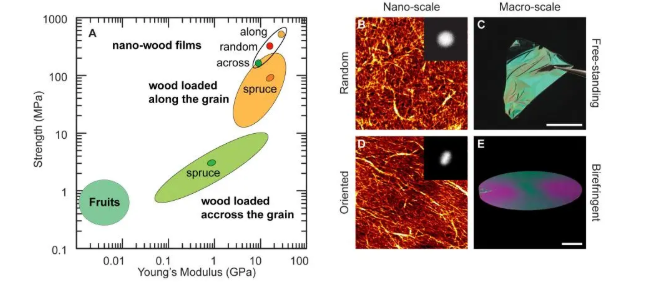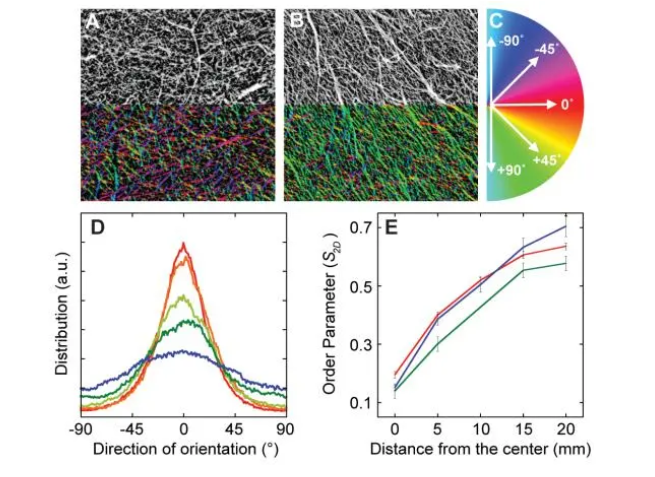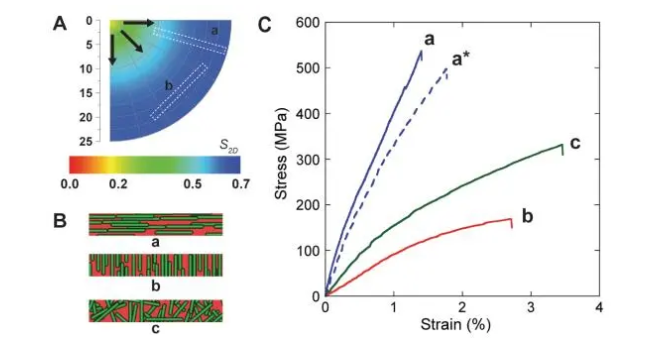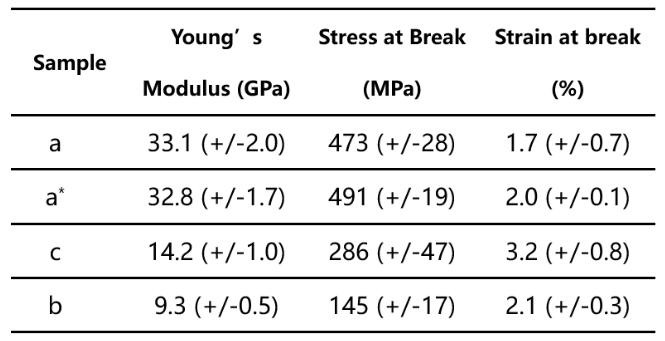QQ Academic Group: 1092348845
Detailed
The layered and anisotropic structure of natural wood makes it lightweight, high-strength and flexible. Among them, cellulose nanofibrils are spirally wound around the wood cell wall in multiple layers, while nano- and micro-sized cellulose fibers can minimize weight and maximize its tensile strength and modulus where it is most needed. Maintaining flexibility perpendicular to the grain direction provides flexibility to the wood. Although nature can organize anisotropic nano-objects such as nanocellulose into complex superstructures, it is difficult to develop synthetic nanocomposites with complex and precisely controlled structures due to the lack of suitable preparation methods.

Figure 1. Orientation of natural and synthetic composite materials
At present, composite materials based on nanocellulose derivatives (cellulose nanocrystals (CNC), cellulose nanofibrils (CNF), etc.) have excellent mechanical strength, low density, and biodegradability. Among them, the anisotropy of a single cellulose nanomaterial in CNF-based composite materials prepared by wet spinning and other methods is averaged, and cannot be fully utilized in a disordered multi-particle system. As we all know, layer-by-layer (LbL) assembly technology is a technology that can be used to prepare multi-component structures with excellent mechanical properties. Both types of nanocellulose (CNF and CNC) have been successfully used to prepare LbL films. Although unidirectional CNF-based LbL films with anisotropic optical properties are prepared by the grazing incidence method (GIS), the existing research on mechanical properties shows that the anisotropic CNF films prepared by GIS are not yet suitable.

Recently, Olivier Felix and Gero Decher (co-corresponding author) of the University of Strasbourg, France, and others jointly reported on a spin-assisted layer-by-layer (LbL) assembly technology composed of anionic cellulose nanofibrils and cationic poly( Vinylamine) composed of anisotropic film. The tensile strength of the film exceeds that of the wood from which the fiber is derived. The orientation degree of nanofibers was studied by atomic force microscope and found that it basically depends on the distance from the center of the spinning surface. In addition, the nanofibrils are preferentially arranged in the direction of the shear flow, so when measured parallel to or perpendicular to the orientation direction of the fibrils, the mechanical properties of this film are very different. In order to realize biomimetic applications including induction, packaging, electronics or optics, the preparation of nanocomposite materials and devices with anisotropic physical properties requires extreme control of the positioning and arrangement of nanoscale objects in the matrix material.
Thick non-directional and directional multilayer assembly
As the number of deposition cycles (up to 200 layer pairs) increases, the thickness of the multilayer film increases linearly, but the thickness increment of the film prepared by the rotation-assisted LbL assembly technology is lower. At 8000 rpm, the interference colors of (PVAm/CNF)n films prepared with rotation-assisted LbL assembly with increasing thickness, and these colors are the characteristic structure colors of films with uniform thickness and refractive index. On the atomic force microscope (AFM) image, the uniformity of the film on the micrometer scale is also obvious.

Figure 2. Growth, thickness and uniformity of CNF-based films
Characterization of CNF alignment in rotation-assisted LbL assembly
The author uses AFM to image the film and uses Orientation J to characterize the orientation of nanofibers, which can be characterized based on pixels. Each pixel is color-coded according to the alignment direction. A typical image obtained near the center and edges of the sample, with corresponding color code. As can be seen from the color-coded image, CNFs are randomly distributed in the center, while they are located at the edges. The orientation distribution under 8000 rpm assembly is shown in Figure 3D. As expected, the direction of the cellulose nanofibers increases from the center to the edges. It should be noted that most images taken at the center of the rotating substrate have some degree of orientation. In all cases, the order parameters increase from center to edge, and the maximum orientation of CNF in the film also increases with the rotation speed.

Figure 3. Characterization of CNF alignment in rotating assisted assembly
Mechanical properties of thick oriented LbL film
The author measured the tensile properties of anisotropic nanocomposites in parallel and perpendicular to the orientation direction, and compared them with isotropic composites prepared by dipping. All the films studied show typical stress-strain curves, and the corresponding data are shown in Table 1. As expected, the Young‘s modulus and tensile strength increased from oriented films perpendicular to the fibril direction (b) to random films (c) and oriented films parallel to the fibril direction (a, a*). Among them, the cellulose nanofibrils are the reinforcing components originating from the excellent mechanical properties of wood, and their tensile modulus is estimated to be 100 GPa, and the breaking strength exceeds 1 GPa. The Young‘s modulus of the oriented film measured perpendicular to the fibril direction was maintained at 9 GPa. When the nanofibrils are parallel to the orientation, they bear most of the stress, and the Young‘s modulus of the film reaches 33 GPa and the tensile strength is 490 MPa.

Figure 4. Tensile properties of nanocomposites

Table 1. Stretching specific data of nanocomposites
The mechanical properties of wood are the result of the delamination and anisotropic arrangement of cellulose fibers in different layers of wood cell walls. The latter is arranged in four discrete layers, the outermost main layer consisting of randomly distributed cellulose microfibers that surround the secondary cell wall. Among them, the secondary cell wall is divided into three consecutive layers (S1, S2, and S3). All layers are made of the same composition (mainly cellulose, hemicellulose and lignin). The S1 layer is mainly composed of lignin (about 70%), while the S2 layer contains the highest content of cellulose (about 50%). ). The S2 layer represents about 70-80% of the hole wall thickness, and is most important for the mechanical strength of the hole, especially in the axial direction.

Figure 5. Schematic diagram of the structure of the wooden cell wall
In short, spin-assisted LbL assembly can quickly prepare a highly anisotropic nano-reinforced composite film composed of cellulose nanofibrils and polyvinylamine over a large area. Using different rotation speeds, CNF-based transparent micron-level films with uniform thickness and high orientation are assembled on silicon wafers. The quantitative tensile properties of the free-standing (CNF/PVAm)n film parallel and perpendicular to the nanofibril direction can prove the macroscopic mechanical anisotropy of the nanocomposite film. This LbL assembly technology can provide a nanocellulose-based material, and the mechanical strength of the material exceeds one of the woods from which the nanofibrils are obtained.
This information is sourced from the Internet for academic exchange only. If there is any infringement, please contact us to delete it immediately.
- Previous: Burst! Prepare perovsk
- Next: IF 19! Reprogram tumor


 Academic Frontier
Academic Frontier